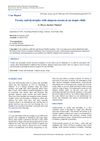Alopecia Areata: A Disorder with a Lifetime Risk of 1-2%
December 2019
in “
Pediatria i Medycyna Rodzinna
”

TLDR Alopecia areata is a hair loss condition that may be linked to stress and genetics, often requires psychological support, and has no set treatment.
Alopecia areata, a disorder with a lifetime risk of 1-2%, is most prevalent in individuals aged 10 to 25 years. The exact cause is unknown, but factors such as autoimmune processes, stress, and genetic vulnerability are believed to play a significant role. The disorder often coexists with depressive or anxiety disorders. Clinically, it presents as sharply demarcated patches of hair loss, with severity ranging from isolated scalp hair loss to total body hair loss. The primary differential diagnosis is androgenetic alopecia. While hair often grows back spontaneously, relapses are common. Treatment involves various drugs, primarily immunomodulatory agents, but there are no established treatment regimens. Antidepressants and psychotherapy are also frequently used. Patients often experience a reduced quality of life due to the disorder, highlighting the importance of psychological support.


